
White Dwarf is a magazine published by British games manufacturer Games Workshop, which has long served as a promotions and advertising platform for Games Workshop and Citadel Miniatures products.

Sir Ian Livingstone is an English fantasy author and entrepreneur. Along with Steve Jackson, he is the co-founder of a series of role-playing gamebooks, Fighting Fantasy, and the author of many books within that series. He is also one of the co-founders of company Games Workshop.
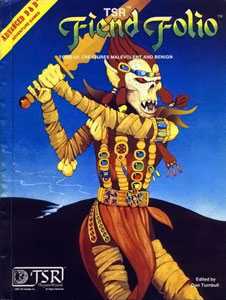
Fiend Folio is the name of three separate products published for successive editions of the fantasy role-playing game Dungeons & Dragons (D&D). All three are collections of monsters.

The Player's Handbook is the name given to one of the core rulebooks in every edition of the fantasy role-playing game Dungeons & Dragons (D&D). It does not contain the complete set of rules for the game, and only includes rules for use by players of the game. Additional rules, for use by Dungeon Masters (DMs), who referee the game, can be found in the Dungeon Master's Guide. Many optional rules, such as those governing extremely high-level players, and some of the more obscure spells, are found in other sources.
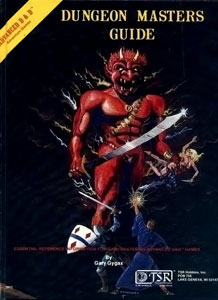
The Dungeon Master's Guide is a book of rules for the fantasy role-playing game Dungeons & Dragons. The Dungeon Master's Guide contains rules concerning the arbitration and administration of a game, and is intended for use by the game's Dungeon Master.

Dungeonland (EX1) is a 1983 adventure module for the Dungeons & Dragons (D&D) roleplaying game, written by Gary Gygax for use with the First Edition Advanced Dungeons & Dragons (AD&D) rules. It is an adaptation of Lewis Carroll's 1865 novel Alice's Adventures in Wonderland, with the various characters from the book translated into AD&D terms.
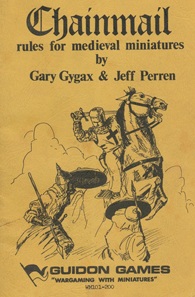
Chainmail is a medieval miniature wargame created by Gary Gygax and Jeff Perren. Gygax developed the core medieval system of the game by expanding on rules authored by his fellow Lake Geneva Tactical Studies Association (LGTSA) member Perren, a hobby-shop owner with whom he had become friendly. Guidon Games released the first edition of Chainmail in 1971.
The Lake Geneva Tactical Studies Association (LGTSA) was a prominent wargaming club active in Lake Geneva, Wisconsin during the early 1970s.
Lenard Lakofka was an American writer of material for the fantasy role-playing game Dungeons & Dragons. Although never a formal employee of TSR, the company that published Dungeons & Dragons, Lakofka was an influential voice in the development of the game. He was one of the playtesters of the game as it was being developed, an editor of early manuscripts, wrote a widely-read monthly D&D magazine column and two official D&D adventures, and had his home campaign setting of the Lendore Isles incorporated into Gary Gygax's World of Greyhawk Fantasy Game Setting.
Marc Gascoigne is a British author and editor.
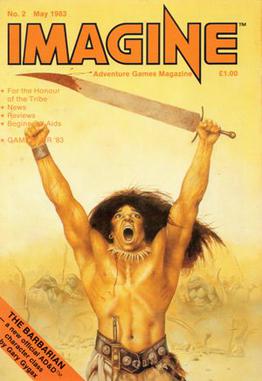
Imagine was a British monthly magazine dedicated to the first edition Advanced Dungeons and Dragons and Dungeons and Dragons role-playing game systems published by TSR UK Limited.
Ian Marsh is a British writer, magazine editor, and entrepreneur.

Owl and Weasel was a newsletter for board gamers, role-playing gamers and wargamers, published in London, England, by Games Workshop. A total of 25 issues were published from February 1975 until April 1977; it was edited by Steve Jackson and Ian Livingstone. It was superseded by White Dwarf.

The Dungeons & Dragons Basic Set is a set of rulebooks for the Dungeons & Dragons (D&D) fantasy role-playing game. First published in 1977, it saw a handful of revisions and reprintings. The first edition was written by J. Eric Holmes based on Gary Gygax and Dave Arneson's original work. Later editions were edited by Tom Moldvay, Frank Mentzer, Troy Denning, and Doug Stewart.
Timothy James Kask is an American editor and writer in the role-playing game industry. Kask became interested in board games in his childhood, and later turned to miniatures wargames. While attending university after a stint in the US Navy, he was part of a group that playtested an early version of the new role-playing game Dungeons & Dragons (D&D) for game co-designer Gary Gygax. Gygax hired him as the first employee of TSR, Inc. in 1975. After editing some of TSR's early D&D publications, Kask became editor of The Strategic Review, which later became The Dragon, and then Dragon Magazine.
Theron O. Kuntz is a game designer who was an early associate of Gary Gygax and employee of TSR.
Don Turnbull was a journalist, editor, games designer, and an accomplished piano and pinball player. He was particularly instrumental in introducing Dungeons & Dragons into the UK, both as the managing director of TSR UK Ltd and as the editor of the Fiend Folio.
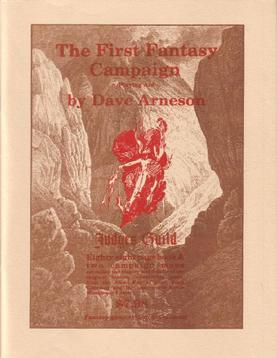
The First Fantasy Campaign is a supplement for fantasy role-playing games written by Dave Arneson and published by Judges Guild in 1977.

The Manual of Aurania is a 24-page supplement for fantasy role-playing games self-published in 1976 and sold at Aero Hobbies, a games store in Santa Monica, California owned by Gary Switzer. A 34-page 2nd edition revision of the book was later published by International Gamers Association with numerous added illustrations in 1977.
Dicing with Dragons is a book written by Ian Livingstone and published by Routledge & Kegan Paul in 1982 that explains what role-playing games are.












